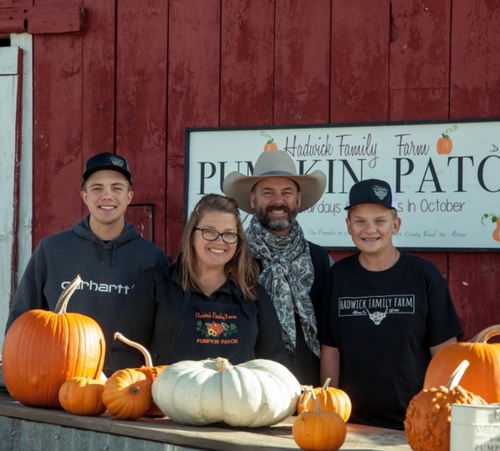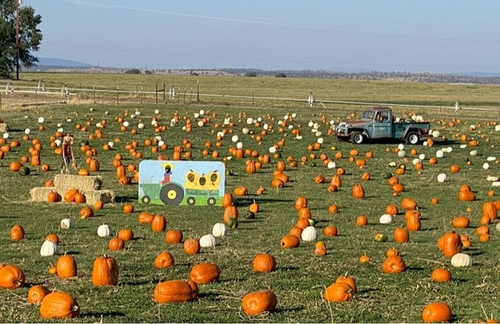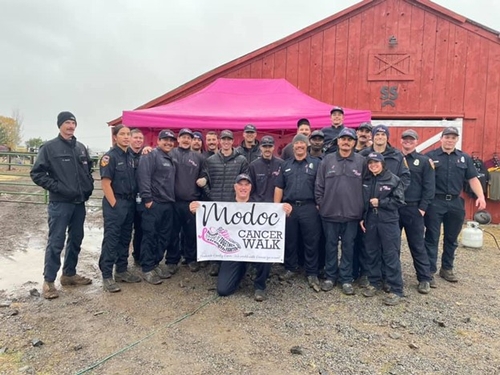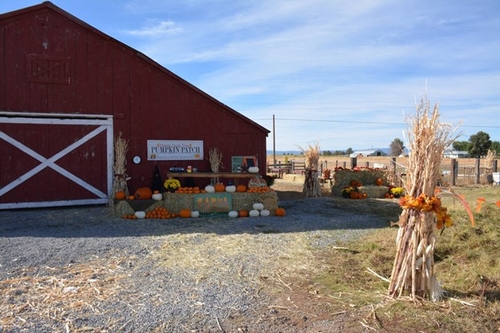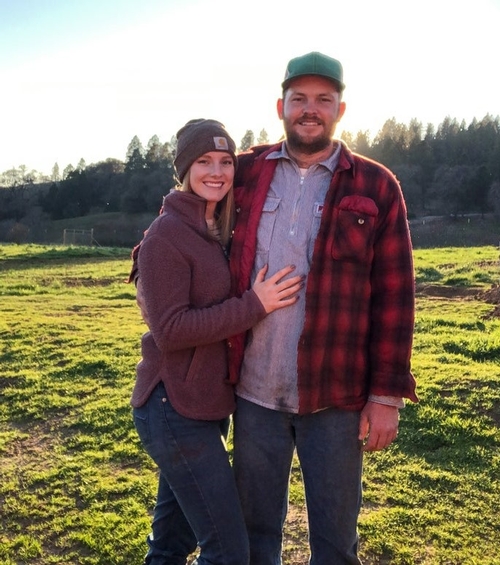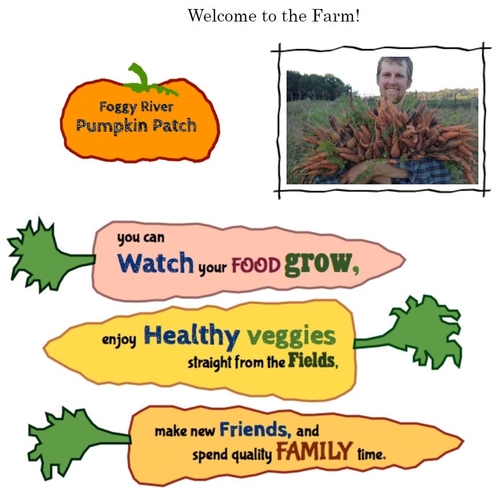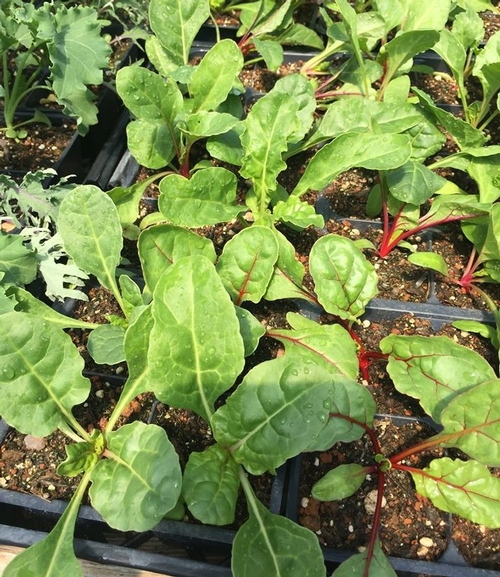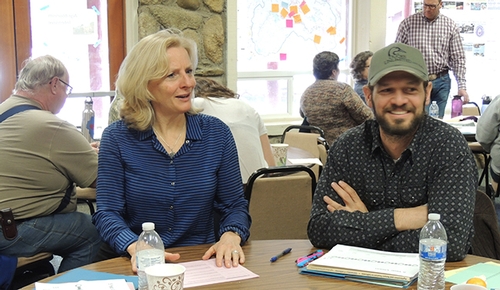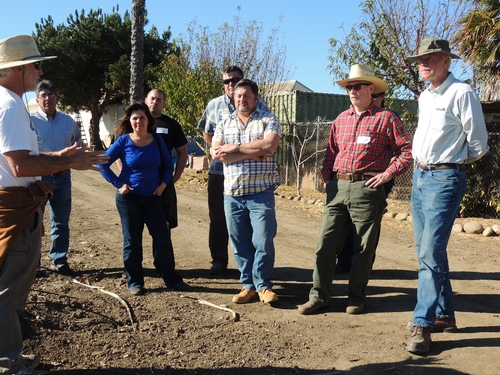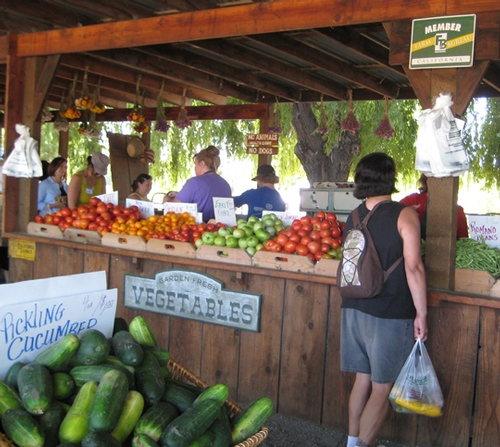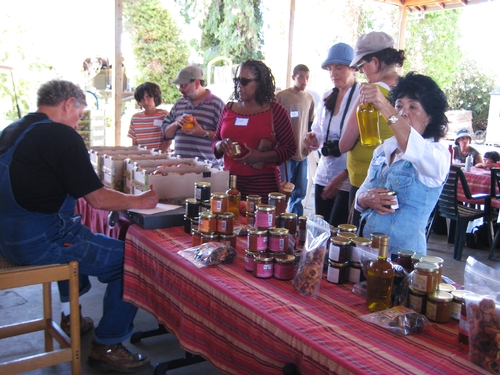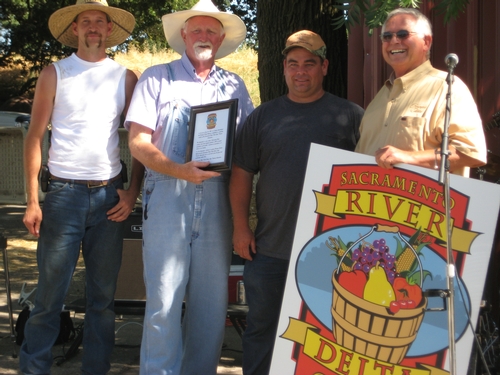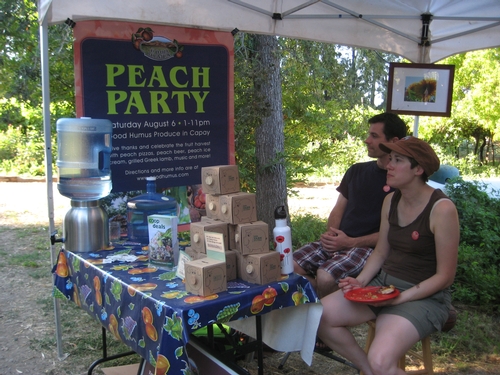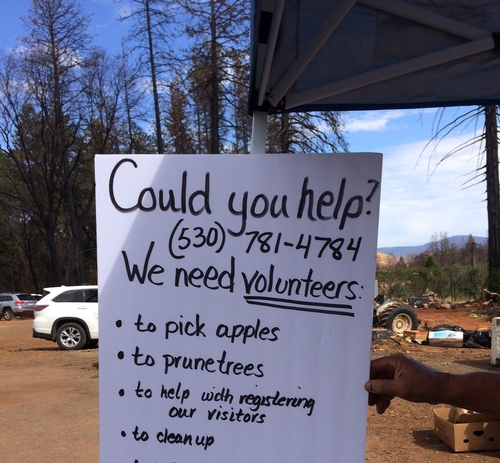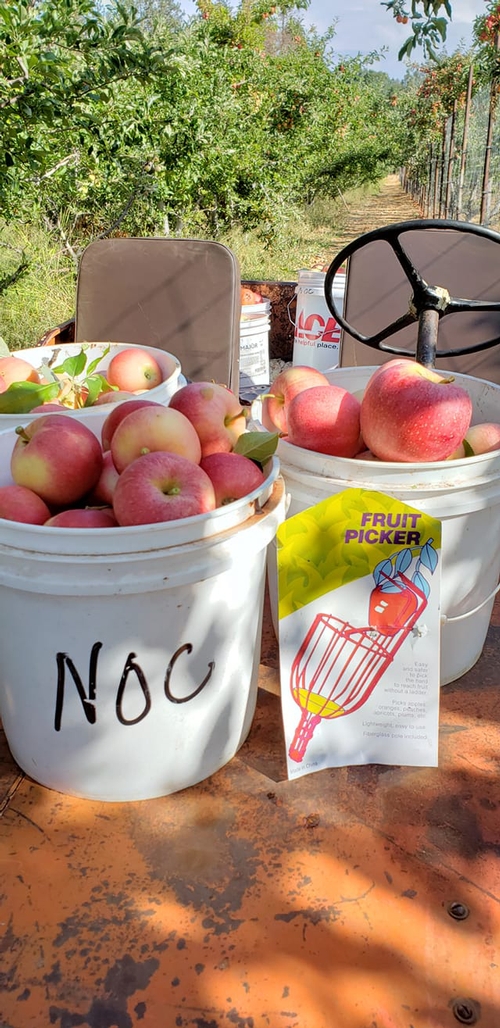
- Author: Rachael Callahan
In 2016, Heather and Bryon Hadwick attended the Agritourism Intensive training, a signature course of the UC ANR Agritourism Program. Heather had been wanting to start a pumpkin patch, Bryon wasn't so sure. When they learned that an Agritourism Intensive was coming to Redding, they saw an opportunity to learn more about what it would take to start an agritourism enterprise and hear from experienced agritourism operators. Six years later, the Hadwick Family Farm Pumpkin Patch has become an October tradition for families from Modoc County and beyond and a launching pad for community engagement and education.
They knew it wouldn't be easy, and it hasn't been. To start, Heather and Bryon both work full-time off-farm jobs. They designed the business to be manageable part-time by the two of them with help from their children, who are now teenagers. Having enough time is only one of their obstacles; they also have to contend with insurance limitations and unpredictable weather. As with all agritourism operations, liability is a major concern. The Hadwick's only found a few insurance companies nationwide that would cover a pumpkin patch. In many ways, the activities that they offer at The Patch, as it is commonly called, are dictated by the insurance costs. For example, they wanted to offer tractor rides, but they would have to charge far more than they were comfortable with to offset the increase in insurance costs.
And then there's the weather. The pumpkin patch is open 3 to 4 weekends a year in October. Modoc's unpredictable weather makes it nearly impossible to project the season's earnings in advance. October has brought snow, rain, and 80-degree weather. Last year, in 2021, they were rained out every single weekend. While enough visitors showed up in their rain gear to keep the business from losing money, the experience made them question whether or not they wanted to keep it going. They moved forward with opening again in 2022, welcoming more visitors on opening day than the entire 2021 season.
Navigating business decisions amongst the limitations and uncertainties of time, insurance, and weather is no doubt challenging, but clear goals and metrics to monitor progress towards reaching those goals have helped guide the Hadwicks. Community is The Patch's founding principal. As Heather puts it, “We see the pumpkin patch as more of a community service. As long as we are in the black, we're good and will keep it going.”
The pumpkin patch itself is geared towards local families, with a keen eye on keeping prices accessible. For the first time this year, pumpkin prices were raised to offset the business's rising operating costs (for one thing, the cost of their insurance doubled this year). Entry remained $5 and includes all activities. Part of these proceeds are donated back to their local FFA chapters. “Our goal is to keep it at $5. We want it to be affordable, most families spend 2 or 3 hours at the Patch.” Heather adds, “There isn't a lot you can do these days for that long for $5 a person.” So when it comes to adding activities like tractor rides that would raise the cost too much for local families, the Hadwick's opt to keep things affordable.
In addition to keeping prices as low as possible, The Patch frequently lends their space to community groups and partners with local businesses. Floral arrangement classes, facepainting at the farm to promote a new cosmetologist business, cancer awareness walks, and frequent collaborations with the local FFA are a few examples of how the Hadwick's use their space to support community efforts and provide agricultural education. Hadwick Family Farm also hosts field trips for schools from Modoc, bordering counties and Oregon schools.
While community collaborations are in line with their business's mission, it also helps with getting the word out, saving them money on marketing. “We are mostly word of mouth. We've tried different advertising venues and word of mouth and social media seem to work the best for us,” according to Heather.
In 2021 and 2022, the UC ANR Agritourism Program partnered with UC Cooperative Extension Modoc County and local nonprofit Modoc Harvest to hold a series of workshops, funded by a USDA Farmers Market Promotion Program grant, for area farmers and community members to explore agritourism opportunities and generate interest in expanding Modoc's agritourism offerings. To supplement a workshop about hosting on-farm events, Hadwick Family Farm Pumpkin Patch hosted their first farm-to-table dinner as a fundraiser for Modoc Harvest. With little agritourism, such as on-farm events, taking place in Modoc County at present, the county does not have a framework for regulating activities, other than the statewide guidelines for farm stands and farm stays. As interest in starting agritourism enterprises increases in Modoc County, UCCE Modoc County and the UC ANR Agritourism Program will work with county regulators and other stakeholders to develop guidelines that clear a path for farmers and ranchers that are interested in expanding their offerings.
In agritourism it is often beneficial to have multiple agritourism enterprises within close proximity that can collaboratively market their businesses and attract a greater number of visitors. Hadwick Family Farm Pumpkin Patch provides a look at an operation that has achieved success by marketing to their local residents and creating community partnerships in the absence of an agritourism network.
In regions like Modoc County that do not have a developed agritourism industry, businesses like Hadwick Family Farm Pumpkin Patch, can serve as proof of concept for the potential viability of agritourism. The Hadwick's success, challenges, and insights can help inform other potential agritourism operators in the area as well as regulators. By taking a chance on opening the only pumpkin patch, and one of the only agritourism operations, in 100 or so miles, the Hadwick's are engaging and educating their community, and possibly leading the way for agritourism in Modoc County.
- Author: Rachael Callahan
- Author: Cooper Limon
Partnering for California
The COVID-19 pandemic hit farmers hard. Supply chains were disrupted and even non-traditional agritourism revenue streams such as hay mazes and on-farm events had to be canceled due to shelter-in-place mandates.
On the other hand, demand for local farm products skyrocketed, and thus many farmers and ranchers needed a quick pivot strategy and a set of new skills.
UC Sustainable Agriculture Research and Education Program (SAREP) was well-positioned to support this shift toward direct sales, pulling in trusted community partners and experienced farmers and ranchers to put together a comprehensive webinar series, “Agritourism and Direct Sales: Best Practices in COVID Times and Beyond”.
Funded by a USDA Farmers Market Promotion Program (FMPP) grant, the webinar series is part of a three-year project, Strengthening California Local Food Networks with Agritourism and Direct Sales, which provides trainings and technical assistance to farmers and ranchers on how to diversify their revenue streams.
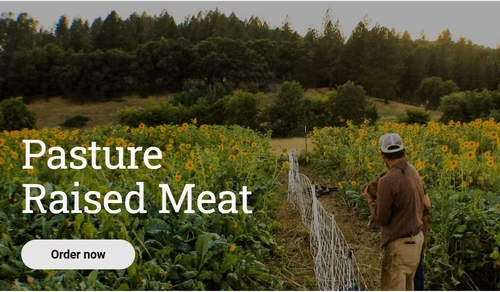
The strength of the series, which includes eight webinars that were recorded earlier this year and are available online, lies in the collaborations among the UC SAREP Agritourism Program, UCCE, community groups, and farmers and ranchers.
The series features a range of speakers, including representatives from community organizations, technical experts, academic researchers, and farmers – all coming together to build resilience and adaptability for small-farming operations and the agritourism industry across California during the pandemic and after.
“It's great to collaborate with other organizations and regions, to learn from each other and to broaden our networks, as we are all working to create more resilient and sustainable food systems,” said Carmen Snyder, executive director of Sonoma County Farm Trails, one of the nonprofit partners on this project.
And because of those strong partnerships, the webinar topics reflected the on-the-ground needs facing agricultural producers.
“COVID initially dramatically affected farmers' restaurant contracts, with many losing more than 80% of their accounts overnight,” Snyder said. “CSAs [Community Supported Agriculture], on the other hand, couldn't keep up with the demand, and all of our CSA members were full and had wait lists for the first time ever. Producers pivoted by creating more online stores, including pick-up and delivery options. It was a challenge for them to navigate the new technology and platforms.”
Unsurprisingly, two of the more popular webinars were “Online Sales Options and Methods” and “Safe, Healthy and Successful Farm Stands”.
The “Online Sales Options and Methods” webinar, a partnership with the Community Alliance with Family Farmers (CAFF), provided an overview of several e-commerce marketing and online sales strategies that farmers can implement to diversify their revenue pathways and reach new customers. CAFF stressed the importance of farmers enhancing their resiliency through e-commerce.
The webinar also featured Ciara Shapiro, the owner of AM Ranch in Penn Valley, who shared her experience with online marketing and how it helped her and her husband survive the pandemic when the restaurants and farmers markets they sold to shut down. This personal and informative webinar demonstrated the effectiveness of online sales and marketing, while highlighting available resources from groups like CAFF.
The “Safe, Healthy and Successful Farm Stands” webinar was aimed at farms of all sizes and organizations that operate or advise agricultural operations using farm stands as a form of revenue. The webinar provided an outline of the rules and regulations that farm stand operators needed to follow during COVID – as well as during business-as-usual times.
It featured two guest speakers who run successful farm stands: Emmett Hopkins, the owner of Foggy River Farm in Sonoma and Reyna Yagi, the farm manager at Petaluma Bounty Farm. They shared their experiences during COVID and how they had to pivot to remain profitable and accessible within state guidelines.
Both farmers saw an increase in farm stand business during the pandemic, which Yagi attributed to the “traffic storm of people” who attended their annual plant sale fundraiser and came to participate in new farm outdoor activities and volunteer opportunities. Yagi also noted the growing number of low-income individuals who were unable to access fresh produce during the pandemic.
The speakers' shared experiences running successful farm stands gave audience members tangible examples and real-time information on how to incorporate farm stands into their businesses.
Carmen Snyder of Sonoma County Farm Trails, which helped circulate the recorded webinars to their network of farmers and ranchers, remarked: “these webinars were extremely helpful for local producers, to get clarity on best pandemic practices during these challenging times and to learn how other producers are adapting and navigating the circumstances.”
- Author: Penny A. Leff
Are you considering agritourism or nature tourism on your farm or ranch?
Would you like to expand your current agritourism or nature tourism business?
Agritourism Intensive 2021 classes are now open for registration by farmers, ranchers, agritourism operators and others involved in agritourism in the Central Coast (SLO) and North Coast (Mendocino) regions.
Learn more & Sign up today to save your space!
Due to COVID-19 restrictions, this year's classes will be mostly virtual, conducted via Zoom, with one in-person field day in each class series if allowed by health authorities. However, each class will be regionally-focused, participatory, and limited to participants from within the region.
- Local agritourism operators will share their own experiences and will be part of a supportive network of advisors as class participants plan and start new enterprises.
- Participants will learn from experts in business planning, regulatory compliance, risk management, hospitality and cost-effective marketing, including social media.
- The hands-on, interactive activities will guide participants as they assess their own farms or ranches for agritourism potential and start their own business, risk management and marketing plans.
- Each participant will receive by US mail a free copy of the extensive handbook, “Agritourism and Nature Tourism in California,” used as a text for the class.
San Luis Obispo class curriculum
SLO Registration:http://ucanr.edu/agtourslo
Mendocino Registration:http://ucanr.edu/agtourmendo
Important: The SLO region Agritourism Intensive classes is open only to farmers, ranchers and others involved in agritourism in San Luis Obispo, Monterey and Santa Barbara Counties.
SLO Class Format: 6 participatory 2-hour Zoom meetings, every Tuesday from January 12, 2021 to February 16, 2021, 9 a.m. to 11:00 a.m. (a possible in-person field day Jan. 26). Shared zoom participation will be available at the SLO Farm Bureau office for those with poor internet access.
SLO Registration: http://ucanr.edu/agtourslo
Important: The Mendocino region Agritourism Intensive class is open only to farmers, ranchers and others involved in or planning agritourism in Mendocino, Lake and Sonoma Counties.
Mendocino Class Format: 4 participatory 2-hour Zoom meetings, every Wednesday morning from March 3, 2021 through March 24, 2021, and one in-person field day on the site of a Mendocino County agritourism operation (location TBD) on March 31.
Mendocino Registration: http://ucanr.edu/agtourmendo
Workshop fee: $40 (for all class sessions, including class text mailed to you and lunch at on-farm field day session)
Information & scholarship options: Penny Leff, paleff@ucanr.edu, 530-902-9763 (cell)
This material is based upon work supported by USDA/NIFA under Award Number 2018-70027-28587.
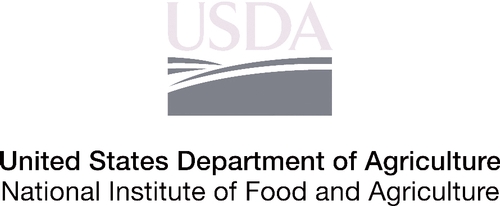

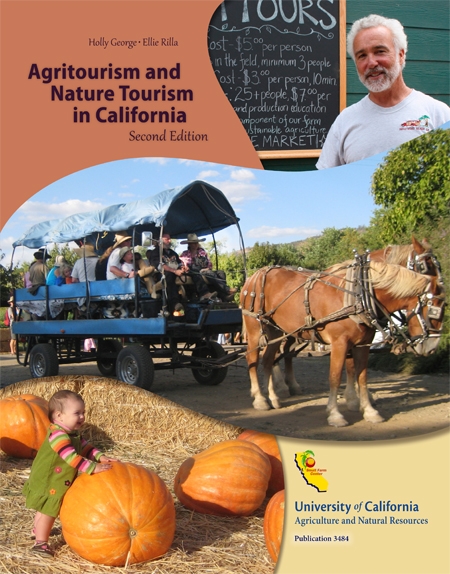
- Author: Penny A. Leff
The USDA Agricultural Marketing Service recently published the recipients of Farmers' Market Promotion Program 2020 grants. The UC Sustainable Agriculture Research and Education Program (UC SAREP) is excited to announce that our project proposal, Strengthening California local food networks with agritourism and direct sales, was selected for funding. UC SAREP will manage this three-year project in collaboration with a team of ANR Cooperative Extension advisors and staff working with established agricultural and agritourism associations to provide education, technical assistance, promotion and networking support for farmers and ranchers throughout California who are engaged in direct marketing and agritourism activities.
With the emergence of “shelter-in-place” directives, California's small-scale direct-marketing farms and agritourism operations faced drastic and immediate disruptions to operations causing major losses in revenue and lay-offs for staff. Particularly hard-hit were agritourism operators who had to cancel visitor- serving activities, often reducing staff or not hiring for seasonal employment. Positively, the disruptions in food supply and mobility brought the existence and importance of local farms and ranches to the attention of much of the public.
Increased awareness by the public of local farms and ranches indicates that potential for local agritourism and direct sales opportunities will increase when shelter-in-place restrictions are relaxed, offering needed options for small-scale farm and ranch diversification. Agritourism can provide farmers and ranchers with diversification options to help reduce risk, but diversifying with agritourism introduces new risks and challenges for producers that can be overcome with training, connections and resources.
The UC ANR team, working under the direction of UC SAREP Director Gail Feenstra and coordinated by UC SAREP Agritourism Coordinator Penny Leff, includes Laura Snell, County Director, UCCE Modoc County, Luis Espino, County Director, UCCE Butte County, Margaret Gullette Lloyd, Small Farms Advisor, UCCE Solano County, Karen Giovannini, UCCE Sonoma County Agruiculture Ombudsman and Laura Crothers, UC SAREP Communication Specialist. We will partner for this project with the Community Alliance with Family Farmers (CAFF) and established producer based agriculture associations Modoc Harvest, Sonoma County Farm Trails, Sierra Oro Farm Trail (Butte Co.) and Pleasants Valley Agriculture Association (Solano Co.).
Training & technical assistance
In Winter 2020-21, with travel and group gathering restrictions still in place, we will enable rapid response to COVID-19 and changing marketing conditions by California's small-scale producers through a series of webinars for farmers and ranchers adopting and adapting new and modified direct marketing and agritourism activities. The series of one-hour webinars (which will be recorded andshared for future use) will be on the topics below:
#1 Online sales options and methods
#2 Getting started with CSAs and box delivery programs
#3 Operating a safe, healthy & successful farm stand
#4 Best practices for U-Pick operations
#5 Best practices for visitor interaction with animals
#6 Best practices for farm tours, workshops and farm-based education
#7 Creative marketing and staying connected with social media
#8 Community collaboration – farm trail groups, tourism connections and other options
In project year two, with the expectation that travel restrictions will be relaxed by Fall 2021, the project will build in-depth, hands-on learning and increased collaboration by farmers and ranchers through a series of four workshops/field days in each of four California regions severely impacted by COVID-19 restrictions. The workshops will be held in Modoc, Sonoma, Solano and Butte Counties. The half-day workshops/field days, held on the farms or ranches of experienced operators of the activities being discussed, will focus on the following topics:
#1 Expanding direct-to-consumer sales through online sales/on-farm pickup, CSAs, farm direct delivery and commercial or contracted shipping
#2 Developing and marketing successful community-serving farm stands and U-Pick Operations
#3 Planning and marketing farm dinners, tours, workshops and other on-farm educational activities for the local community
#4 Community collaboration, community events and shared marketing - examples and best practices for increased connections, producer support, successful marketing and shared operations
Marketing: Connecting farms and ranches to local communities for resilient local food systems
During the project, the experienced leaders of the four partnering agricultural associations will conduct marketing campaigns promoting direct sales and agritourism activities at local farms to local communities. The campaigns will be different in each region, but will include a mix of social media marketing, print, radio and paid media advertising, signs, postcards, fliers, and creative collaborative direct sales and agritourism events or activities.
Organizing: Regional networks for ongoing support of direct sales and agritourism
The agricultural marketing association leaders will also convene and facilitate quarterly meetings of regional “Direct Sales and Agritourism Networking Groups.” Each networking group will include the partnering organizations as well as regional farmers' market associations, tourism bureaus and local farm advocates, and will regularly discuss issues, provide peer support, and work together to strengthen local food security and connect farmers and ranchers with their communities through direct sales and agritourism.
We are excited to begin this project and look forward to working with California farmers, ranchers and their communities to strengthen skills and collaboration and increase revenue to small-scale producers.
Funding for this project was made possible by the U.S. Department of Agriculture's (USDA) Agricultural Marketing Service through grant #AM200100XXXXG177. Its contents are solely the responsibility of the authors and do not necessarily represent the official views of the USDA.
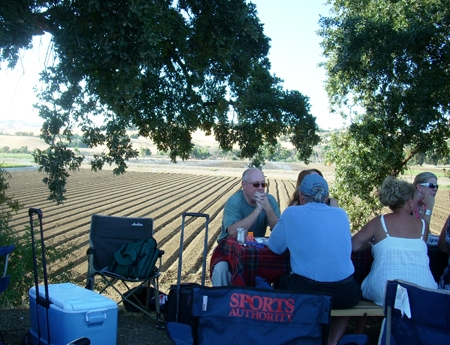
- Author: Penny Leff
Noble Orchards in Paradise, California is the last remaining apple orchard in Butte County. This family business, with close to a hundred years of history, lost almost everything in the Camp fire last year, including all the infrastructure, buildings, fences, ladders, tools, boxes, scales and other things needed to maintain the orchard. But, miraculously, the apple orchards survived the fire.
The bloom was strong this spring. The native bees happily pollinated all the apples. Now the apple trees are heavily laden with fruit ready to pick. Farm owners Jim and Laurie Noble are inviting the public to come to the farm to pick the apples. There are about 80,000 pounds of crisp, delicious apples remaining on the trees.
Here is their message:
JOIN US THIS Wednesday, October 9 (or next Wed - Fri, Oct. 16-18) - 8:30 AM TO 4:00 PM
TO U-PICK
No Charge - donations welcome
Noble Orchards: 7050 Pentz Road, Paradise, CA 95969
"We welcome one and all to come pick our large bounty of fruit this season. As most everyone knows the apple orchards survived the Camp Fire, the infrastructure needed to manage harvesting fruit is 100% missing.
Thank you to our trees for carrying on production without our assistance. No cultural practices were used to help produce tasty, sweet and crunchy apples. With all that said, please come and get them.
OUR RULES: BE SAFE!!!
1.Closed toed shoes and long pants for everyone.
2 No running anywhere and no one climbing in our fruit trees.
3. Bring containers to haul fruit home, picking sticks to reach high fruit, wagons etc to move fruit from orchards.
4. Take all you can possibly use, share with others who are unable to pick themselves, take apples to local food programs, use them as you please, make a gift basket for all the fall fundraisers, most importantly enjoy the bounty you pick!
5. Offer to volunteer here at the farm. We need a lot of assistance both picking now as well as pruning and cleaning up the orchards this fall and winter. Sign up at the farm when you visit
JOIN US THIS Wednesday, October 9 - 8:30 AM TO 4:00 PM
TO U-PICK
No open picking next weekend. The Sierra Oro Farm Trail is a ticketed event we will host both Sat 10/12 and 10/13. Tickets are available at Sierra Oro Farm Trail 2019. Get yours TODAY.
U-Pick will be open again Wednesday - Friday October, 16, 17 and 18.
For more information, updates and future U-Pick dates, see the Noble Orchard Facebook page
